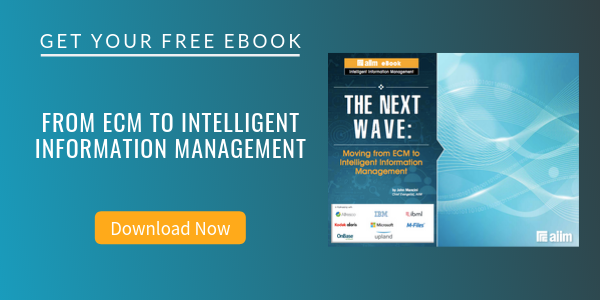
How to Tackle the Information Chaos Problem
Intelligent Information Management (IIM) | Digital Transformation
Many organizations are on some sort of Digital Transformation journey – or they should be. Everyone wants to “transform"; but what exactly is Digital Transformation?
Most organizations and departments have a mandate to continuously improve operations. A conventional change agenda involves better tools and technology, better behaviors, and better processes; all focused on generating better efficiencies and improved productivity.
Ultimately, AIIM believes Digital Transformation is more than conventional change. Digital Transformation is about using information in brand new ways. Digital Transformation success or failure fundamentally rests upon radically redefined experiences with customers, employees, and partners.
Standing in the way of most Digital Transformation initiatives is information chaos, information chaos that is more pervasive and potentially debilitating than ever before.
I recently spoke with Petra Beck from Kodak Alaris about the impact of information chaos on well-intentioned Digital Transformation initiatives.
JM: How does consumerization and mobility make data chaos more challenging?
Petra Beck: Data or information chaos is more challenging than ever before. There are two reasons: 1) there is more chaos, and 2) it is more challenging as the expectations and requirements are increasing.
Businesses today are dealing with the exponential growth of data. There are paper-based business inputs, and there are vast amounts of digital documents coming to you in various formats – such as video, phone calls, chat logs, web analytics, and more – and from multiple sources, including social media channels, customer care centers, online and offline.
Analysts predicted digital data to double every two years - but this was before the Internet of Things (IoT) even appeared on the radar. Data volume is now measured in zettabytes, a trillion gigabytes! Mobile devices are a key driver for the data.
Expectations are increasing. There is a desire to process business inputs with a higher level of automation, meaning quicker and with less human intervention. In a B2C environment these requirements are driven by the end customer, meaning the bank customer who applies for a mortgage – expectation is to have this completed in 30 minutes.
Consumerization drives these changing requirements. Why would an insurance customer accept submitting data for an insurance claim in paper and then waiting for days/weeks as in the past? They will simply find another company with whom to do business.
JM: What are the business implications of failing to solve the “chaos” problem?
Petra Beck: The exponential growth of what can be described as data chaos, or “big data” doesn’t allow workarounds. Business processes that rely on significant manual interventions are no longer feasible when the volume of data, formats, sources, and locations keep increasing.
What are the business implications of failing to address the data chaos challenge? The top ones that come to mind impact on profitability, compliance risk, and falling behind the competition.
Profitability impact is caused by slow, inefficient processes; a transaction with multiple manual steps consumes labor, impacts order to cash, and in a B2C environment, also impacts the customer satisfaction due to delays and errors.
Compliance risk is significant if regulatory and privacy requirements are not met. Fines can be rather significant, not even considering the impact on the company's reputation.
Back-office to front-office inefficiency -- The biggest inefficiency factor for the front-office is looking for documents or the right version of a document. This consumes a clerk’s attention rather than focusing on the customer and impacts the time spent serving customers.
JM: Where can you start? -- How can you begin to break the cycle of information chaos?
Petra Beck: Starting with a front-office process may be the best way to begin tackling the information chaos challenge. Pick your most business-critical workflow and map out the process steps with data streams and data repositories. Then identify the biggest bottlenecks in your processes. Quantify the impacts to the business that affect profitability, productivity, and long-term success. Drive unnecessary complexity out of the workflow and focus on automating process steps that are most impactful – information capture is one to consider due to impact on the downstream process.
JM: What are the role of machine learning and intelligent capture in breaking the chaos cycle?
Petra Beck: At a recent software conference I attended, every vendor was either offering or working on an Artificial Intelligence based solution. But at the same time, businesses are still struggling with the basics – too many data silos and not enough skilled workers.
Intelligent Capture is the starting point. Being able to handle different types of business inputs in one cohesive process is a key prerequisite for reaching a higher level of automation. Image Science plays a key role as well, starting with the intelligent enhancement of scanned images that reduces prep time (a key bottleneck) and exception processing (which is another huge bottleneck).
AI and machine learning are marking a step-change in the automation of business processes. Processes are rarely stable and can be handled with rules-based processes; AI-based processes will allow adjusting processes to reflect a new business situation dynamically.
About John Mancini
John Mancini is the President of Content Results, LLC and the Past President of AIIM. He is a well-known author, speaker, and advisor on information management, digital transformation and intelligent automation. John is a frequent keynote speaker and author of more than 30 eBooks on a variety of topics. He can be found on Twitter, LinkedIn and Facebook as jmancini77. Recent keynote topics include: The Stairway to Digital Transformation Navigating Disruptive Waters — 4 Things You Need to Know to Build Your Digital Transformation Strategy Getting Ahead of the Digital Transformation Curve Viewing Information Management Through a New Lens Digital Disruption: 6 Strategies to Avoid Being “Blockbustered” Specialties: Keynote speaker and writer on AI, RPA, intelligent Information Management, Intelligent Automation and Digital Transformation. Consensus-building with Boards to create strategic focus, action, and accountability. Extensive public speaking and public relations work Conversant and experienced in major technology issues and trends. Expert on inbound and content marketing, particularly in an association environment and on the Hubspot platform. John is a Phi Beta Kappa graduate of the College of William and Mary, and holds an M.A. in Public Policy from the Woodrow Wilson School at Princeton University.



